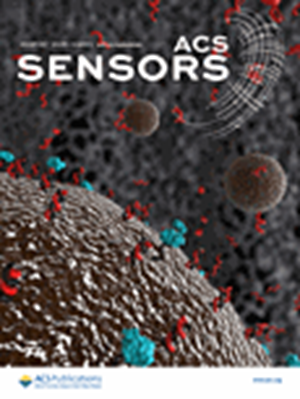石墨烯传感特性中衬底效应的阐释──有机溶剂与石墨烯界面
IF 9.1
1区 化学
Q1 CHEMISTRY, ANALYTICAL
引用次数: 0
摘要
大多数石墨烯传感器的研究都集中在石墨烯的直接改性上,以提高性能。然而,支撑衬底对石墨烯传感机制的影响仍未得到充分研究。由于石墨烯的二维结构,衬底会影响其表面电位、润湿性和分子吸附。在极性分子(例如水分子)存在时,这些效应会加剧,使传感特性进一步复杂化。为了探索这些效应,本研究通过电输运测量研究了衬底对石墨烯场效应晶体管(gfet)在有机溶剂中的传感能力和机制的影响。具体来说,我们比较了部分悬浮石墨烯fet (ps - gfet)和氧化负载石墨烯fet (os - gfet)对不同浓度二甲亚砜(DMSO)、乙醇和异丙醇(IPA)的响应。通过量化狄拉克点迟滞,我们实验证明迟滞与分子极性相关,遵循DMSO <;乙醇& lt;异丙醇。此外,在检测有机溶液浓度时,os - gfet的灵敏度比ps - gfet提高了1.5倍。利用二维氢键网络(2D-HBNS)模型,我们从理论上说明了疏水PS-GFET表面通过水化壳和2D-HBNS的形成来维持平衡。相反,亲水OS-GFET表面破坏了这种平衡,增强了范德华相互作用并吸引了有机分子。这导致os - gfet具有优越的灵敏度。为了进一步验证这一假设,我们在SiO2衬底上引入了聚甲基丙烯酸甲酯(PMMA)和聚四氟乙烯(PTFE)层。实验表明,它改变了石墨烯-表面亲水性和石墨烯-传感器灵敏度。这些发现为优化基于石墨烯的传感器建立了理论和实验框架。该框架阐明了极性液体的溶质-溶剂界面相互作用模型,旨在改善二维材料的传感特性。本文章由计算机程序翻译,如有差异,请以英文原文为准。

An Elucidation of Substrate Effects in Graphene-Based Sensing Characteristics─Interfaces between Organic Solvent and Graphene
Most graphene-sensor researches have focused on direct graphene modifications to enhance performance. However, supporting-substrate effects on graphene sensing mechanisms remain underexplored. Because of graphene 2D architecture, substrates affect its surface potential, wettability, and molecular adsorption. These effects intensify in the presence of polar molecules, e.g., water molecules, further complicating the sensing characteristics. To explore these effects, this study investigates the influence of substrate on the sensing capabilities and mechanisms of graphene field-effect transistors (GFETs) in organic solvents through electrical-transport measurements. Specifically, we compare partially suspended graphene FETs (PS-GFETs) and oxide-supported graphene FETs (OS-GFETs) in response to dimethyl sulfoxide (DMSO), ethanol, and isopropanol (IPA) at different concentrations. By quantifying Dirac-point hysteresis, we experimentally show that the hysteresis correlates with molecular polarity, following the trend DMSO < ethanol < IPA. Moreover, OS-GFETs exhibit a 1.5-fold sensitivity enhancement compared to PS-GFETs when detecting organic solution concentrations. Employing the two-dimensional hydrogen bond network (2D-HBNS) model, we theoretically illustrate that hydrophobic PS-GFET surfaces maintain equilibrium through hydration shell and 2D-HBNS formation. In contrast, hydrophilic OS-GFET surfaces disrupt this balance, enhancing van der Waals interactions and attracting organic molecules. This leads to superior sensitivity in OS-GFETs. To further validate this hypothesis, we introduced poly(methyl methacrylate) (PMMA) and polytetrafluoroethylene (PTFE) layers on the SiO2 substrate. The experiments show it changes graphene-surface hydrophilicity and graphene-sensor sensitivity. These findings establish a theoretical and experimental framework for optimizing graphene-based sensors. This framework elucidates a solute–solvent interfacial interaction model for polar liquids, aiming to improve the sensing characteristics of 2D materials.
求助全文
通过发布文献求助,成功后即可免费获取论文全文。
去求助
来源期刊

ACS Sensors
Chemical Engineering-Bioengineering
CiteScore
14.50
自引率
3.40%
发文量
372
期刊介绍:
ACS Sensors is a peer-reviewed research journal that focuses on the dissemination of new and original knowledge in the field of sensor science, particularly those that selectively sense chemical or biological species or processes. The journal covers a broad range of topics, including but not limited to biosensors, chemical sensors, gas sensors, intracellular sensors, single molecule sensors, cell chips, and microfluidic devices. It aims to publish articles that address conceptual advances in sensing technology applicable to various types of analytes or application papers that report on the use of existing sensing concepts in new ways or for new analytes.
 求助内容:
求助内容: 应助结果提醒方式:
应助结果提醒方式:


